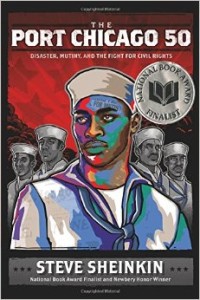Take a look at our selection of hot new releases and popular kids' books and let us know which titles and covers catch your eyes. There are so many amazing new kids books coming in 2016!
Add a CommentViewing: Blog Posts Tagged with: labour intensive, Most Recent at Top [Help]
Results 1 - 5 of 5
Blog: The Children's Book Review (Login to Add to MyJacketFlap)
JacketFlap tags: Mary Pope Osborne, Philip Reeve, Linda Ashman, Hillary Rodham Clinton, Nicola Davies, Random House Books for Young Readers, Leuyen Pham, Simon & Schuster Books for Young Readers, Rosanne Parry, Scholastic Press, Philomel Books, Balzer + Bray, Running Press Kids, Shannon Hitchcock, Salina Yoon, Adele Griffin, Joyce Hesselberth, Chris Grabenstein, Sarah Mcintyre, Sal Murdocca, Elizabeth Rose Stanton, Brooke Boynton Hughes, Paula Wiseman Books, Best Books for Kids, Best Kids Stories, Feiwel & Friends, Mike Curato, HMH Books for Young Readers, Toni Yuly, Henry Holt and Co. books, Best New Kids Books, Dan Gemeinhart, Bloomsbury USA Books, Annabel Wright, Chloe Bonfield, Lois Sepahban, Katrina Nannestad, Susan B. Katz, Eiko Ojala, J.J. Austrian, Ages 0-3, Ages 4-8, Ages 9-12, Kirby Larson, Book Lists, Oliver Jeffers, Farrar Straus and Giroux, featured, Michelle Markel, Add a tag
Blog: First Book (Login to Add to MyJacketFlap)
JacketFlap tags: First Book Favorites, Doug Swieteck, The Port Chicago 50, Baseball, Japan, Book lists, Books & Reading, Michelle Markel, Apollo 11, Gary D. Schmidt, Melissa Sweet, Aaron Meshon, Steve Sheinkin, Brian Floca, Add a tag
This month on Five First Book Favorites you’ll find books that help kids understand civil rights and fair wages, explore different cultures… or even explore the moon!
For PreK – 1st (Ages 2-6)
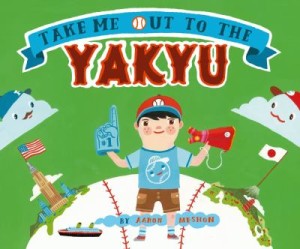 Take Me Out To The Yakyu By Aaron Meshon
Take Me Out To The Yakyu By Aaron Meshon
The narrator of this delightful book is a boy who loves baseball – in two different countries! He goes to games in the U.S. with his American grandfather (pop pop) and games in Japan with his Japanese grandfather (ji ji). Bold, colorful illustrations show, side-by-side, the trip to each stadium. It’s a wonderful invitation for kids to compare and contrast two different experiences and also reflect on the countries and cultures of their own families.
For Grades 1-3 (Ages 5-8)
Brave Girl: Clara and the Shirtwaist Makers’ 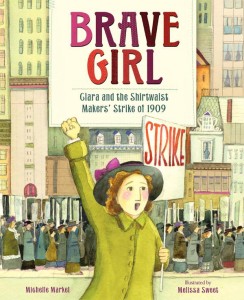 Strike of 1909 written by Michelle Markel and illustrated by Melissa Sweet
Strike of 1909 written by Michelle Markel and illustrated by Melissa Sweet
Clara Lemlich immigrated to New York with nothing aside from her family, clothes, and a few words of English. When her parents were unable to find work, she took a job as a garment factory worker – earning a few dollars a month for countless hours bent over a sewing machine. With a blend of vivid watercolors and stitched fabrics, this book tells the story of how Clara led her coworkers on strike to protest their horrendous working conditions. Bosses of the factories paid for Clara to be beaten and arrested repeatedly, but nothing could stop this gritty, five-foot tall woman from securing a better life for millions.
For Grades 2-5 (Ages 6-10)
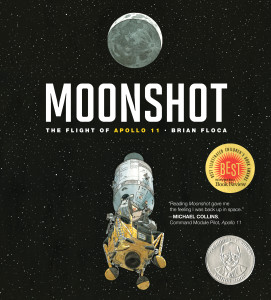 Moonshot: The Flight of Apollo 11 by Brian Floca
Moonshot: The Flight of Apollo 11 by Brian Floca
The moment Apollo 11’s Eagle touched down on the Moon, it became a defining moment for a nation that had lived up to a President’s lofty goal. With stunning illustrations, this poetic story allows you to join Armstrong, Collins, and Aldrin as they prepare for liftoff, follows them at every stage of the mission, and doesn’t let go until they are safely back home. Brian Floca has created a work of art worthy of inspiring young readers to dream beyond what is easy, and strive for what is hard.
For Grades 5+ (Ages 10 and up)
The Port Chicago 50: Disaster, Mutiny, and the Fight for Civil Rights by Steve Sheinkin
Loading 500-pound bombs into a Navy warship is, to say the least, a dangerous job. On July 17th, 1944, the fears of the untrained men who held this job became reality when an explosion claimed the lives of 320 men, the majority of whom were black. During this time, the Navy, like every other part of the United States Military, was segregated,frequently leaving black men to be treated as second class citizens serving menial roles. This masterfully crafted nonfiction book follows the fifty men who refused to go back to this life-threatening and degrading work, and the court case that followed.
For Grades 6+ (Age 11 and up)
 Okay for Now by Gary D. Schmidt
Okay for Now by Gary D. Schmidt
There are few characters you will ever root for more than Doug Swieteck. On the surface, he is a good for nothing, skinny thug with a reading disability. Just ask his teachers and they’ll tell you. However in the depths of Doug Swieteck, where this book takes place, you find a boy who is trapped – one brother a bully, one a vacant shell of his pre-war self, and an abusive alcoholic for a father who has left a horrific mark on his youngest son. The secrets Doug is holding back from the reader are gut-wrenching, but with the help of a few strangers-turned-friends and a newfound passion for art, this fourteen-year-old will inspire every person lucky enough to pick up his story.
The post Our Five Favorite Books This February appeared first on First Book Blog.
Blog: A Fuse #8 Production (Login to Add to MyJacketFlap)
JacketFlap tags: 2012 reviews, Best Books of 2012, 2012 biographies, 2012 nonfiction, 2012 picture book biographies, 2012 nonfiction picture books, nonfiction, nonfiction picture books, biographies, Eerdmans Books for Young Readers, Michelle Markel, picture book biographies, Uncategorized, Amanda Hall, 2012 Sibert Award contender, Add a tag
 The Fantastic Jungles of Henri Rousseau
The Fantastic Jungles of Henri Rousseau
By Michelle Markel
Illustrated by Amanda Hall
Eerdmans Books for Young Readers
$17.00
ISBN: 978-0-8028-5264-6
Ages 4-8
On shelves now
I’m not ashamed to say it, though perhaps I should be. Still, it’s true. Though I grew up in the middle class with a good education and a stint at a liberal arts college there are huge gaping gaps in my knowledge that have consistently been filled in over the years by children’s books. I know that I am not alone in this. When I worked in NYPL’s Central Children’s Room we had any number of regular adult patrons that would come in seeking children’s books on a variety of different topics so that they could learn about them in a non-threatening fashion. At its best a children’s book takes a complex subject and synthesizes it down to its most essential parts. Simple enough. But if you’re dealing with a picture book biography, it then has to turn a human life in a cohesive (child friendly) story. No mean feat. So when I saw this picture book bio of the artist Henri Rousseau I was immediately arrested by its art. Then I sort of came to realize that when it came to the man himself, I knew nothing. Next to nothing. I may never win a Jeopardy round or a game of Trivial Pursuit but thanks to great books like this one I may someday attain the education of a seven-year-old. There are worse fates in the world. These days, seven-year-olds get all the good stuff.
Your everyday average forty-year-old toll collector doesn’t usually drop everything to become a painter, yet that’s exactly what one did back in the 19th century. His name was Henri Rousseau and though he never took an art course in his life (art lessons aren’t exactly available on a toll collector’s budget) he does his research, looks at art, sits himself down, and begins to paint. He’s incredibly excited after his first big exhibition but his reviews say mostly “mean things” about his art. Still, he clips them, saves them, and continues to paint. Over the years he meets with very little success but is inspired by greenhouses and the lush topiary found inside. He can’t afford to ever see a jungle of his own so he makes them up. Finally, after decades and decades, the new young crop of artists takes note of his work. At last, he is celebrated and appreciated and his naïf style is seen for what it truly is; Simultaneously ahead of its time, and timeless.
 As far as I can tell the picture book biography can go in a certain number of directions when it comes to its interior art. It can seek to emulate the original artist, mimicking their style with mixed results. Or it can eschew the original artist altogether and only show their paintings as images on walls or in the notes at the book’s end. Artist Amanda Hall takes a slightly different take with her art, inserting Mr. Rousseau into his own works. As she says at the end “Instead of my usual pencil crayon and watercolor technique, I used both watercolor and acrylics for the illustrations, as I wanted to get close to the feel of Rousseau’s own paintings. I decided to break the rules of scale and perspective to reflect his unusual way of seeing the world. For some of the illustrations I drew directly on his actual paintings, altering them playfully to help tell the story.” That right there might be the book’s difference. I think that for many of us, the joy of an Henri Rousseau painting lies not in the composition necessarily (though that is a plus) but the sheer feel of the piece. Rousseau’s jungle scenes do not look or feel like anyone else’s and Hall has done a stellar job capturing, if not the exact feel, then a winning replica of it for kids. The endpapers of this book are particularly telling. Open the cover and there you find all the usual suspects in a Rousseau landscape, each one creeping and peeking out at you from behind the ferns and oversized blossoms.
As far as I can tell the picture book biography can go in a certain number of directions when it comes to its interior art. It can seek to emulate the original artist, mimicking their style with mixed results. Or it can eschew the original artist altogether and only show their paintings as images on walls or in the notes at the book’s end. Artist Amanda Hall takes a slightly different take with her art, inserting Mr. Rousseau into his own works. As she says at the end “Instead of my usual pencil crayon and watercolor technique, I used both watercolor and acrylics for the illustrations, as I wanted to get close to the feel of Rousseau’s own paintings. I decided to break the rules of scale and perspective to reflect his unusual way of seeing the world. For some of the illustrations I drew directly on his actual paintings, altering them playfully to help tell the story.” That right there might be the book’s difference. I think that for many of us, the joy of an Henri Rousseau painting lies not in the composition necessarily (though that is a plus) but the sheer feel of the piece. Rousseau’s jungle scenes do not look or feel like anyone else’s and Hall has done a stellar job capturing, if not the exact feel, then a winning replica of it for kids. The endpapers of this book are particularly telling. Open the cover and there you find all the usual suspects in a Rousseau landscape, each one creeping and peeking out at you from behind the ferns and oversized blossoms.
A poorly made picture book bio will lay out its pictures in a straightforward dull-as-dishwater manner never deviating or even attempting to inject so much as an artistic whim. The interesting thing about Hall’s take on Rousseau is that while, yes, she plays around with scale and perspective willy-nilly, she also injects a fair amount of whimsy. Not just the usual artist-flying-through-the-air-to-represent-his-mental-journey type of stuff either. There is a moment early on when a tiny Rousseau pulling a handcart approaches gargantuan figures that look down upon him with a mixture of pop-eyed surprise and, in some cases, anger. Amongst them, wearing the coat and tails of gentlemen, are two dogs and one gorilla. Later Hall indicates the passing of the years by featuring three portraits of Rousseau, hair growing grey, beard cut down to a jaunty mustache. On the opposite page three critics perch on mountains, smirking behind their hands or just gaping in general. It’s the weirdness that sets this book apart and makes it better than much of its ilk. It’s refreshing to encounter a bio that isn’t afraid to make things odd if it has to. And for some reason that I just can’t define . . . it definitely has to.
 But to get back a bit to the types of bios out there for kids, as I mentioned before Hall inserts Rousseau directly into his own painting when we look at his life. Done poorly this would give the impression that he actually did live in jungles or traipse about with lions, and I’m sure there will be the occasional young reader who will need some clarification on that point. But in terms of teaching the book, Hall has handed teachers a marvelous tool. You could spend quite a lot of time flipping between the paintings here and the ones Rousseau actually created. Kids could spot the differences, the similarities, and get a good sense of how one inspired the other. Near the end of the book Hall also slips in a number of cameos from contemporary artists, and even goes so far as to include a key identifying those individuals on the last few pages. Imagine how rich an artistic unit would be if a teacher were to take that key and pair it with the author bios of THOSE people as well. For Gertrude Stein just pull out Gertrude is Gertrude is Gertrude is Gertrude by Jonah Winter. Pablo Picasso? A quick look at The Boy Who Bit Picasso by Antony Penrose. Lucky kids.
But to get back a bit to the types of bios out there for kids, as I mentioned before Hall inserts Rousseau directly into his own painting when we look at his life. Done poorly this would give the impression that he actually did live in jungles or traipse about with lions, and I’m sure there will be the occasional young reader who will need some clarification on that point. But in terms of teaching the book, Hall has handed teachers a marvelous tool. You could spend quite a lot of time flipping between the paintings here and the ones Rousseau actually created. Kids could spot the differences, the similarities, and get a good sense of how one inspired the other. Near the end of the book Hall also slips in a number of cameos from contemporary artists, and even goes so far as to include a key identifying those individuals on the last few pages. Imagine how rich an artistic unit would be if a teacher were to take that key and pair it with the author bios of THOSE people as well. For Gertrude Stein just pull out Gertrude is Gertrude is Gertrude is Gertrude by Jonah Winter. Pablo Picasso? A quick look at The Boy Who Bit Picasso by Antony Penrose. Lucky kids.
Just as the art of a picture book biography can go any number of directions, the storytelling is in the same boat. You want to tell the life of a man. Fair enough. Do you encompass everything from birth to death, marking dates and important places along the way? Do you synthesize that life down to a single moment and then use your Author’s Note at the end to tell why that person is important at all (many is the Author’s Note forced to do the heavy lifting). Or do you just zero in on what it is that made that person famous in the first place and look at how they struggled with their gift? Author Michelle Markel opts for the latter. A former journalist, Markel first cut her teeth on the author bio with her lovely Dreamer from the Village: The Story of Marc Chagall. Finding that these stories of outsider artists appealed to her, the move to Rousseau was a natural one. One that focuses on the man’s attempts to become an artist in the face of constant, near unending critical distaste. Markel’s gift here is that she is telling the story of someone overcoming the odds (to a certain extent . . . I mean he still died a pauper an all) in the face of folks telling him what he could or couldn’t do. It’s inspirational but on a very gentle scale. You’re not being forced to hear a sermon on the joys of stick-to-itativeness. She lands the ending too, effortlessly transitioning from his first successful debut at an exhibition to how he is remembered today.
I remember having to learn about artists and composers in elementary school and how strange and dull they all seemed. Just a list of dead white men that didn’t have anything to do with my life or me. The best picture book bios seek to correct that old method of teaching. To make their subjects not merely “come alive” as the saying goes but turn into flesh and blood people. You learn best about a person when that person isn’t perfect, has troubles, and yet has some spark, some inescapable something about them that attracts notice. A combination of smart writing and smarter art is ideal, particularly when you’re dealing with picture book biographies. And The Fantastic Jungles of Henri Rousseau is nothing if not smart. It typifies the kind of bios I hope we see more of in the future. And, with any luck, it will help to create the kinds of people I’d like to see more of in the future. People like Henri Rousseau. Whatta fella. Whatta book.
On shelves now.
Source: Final copy sent from publisher for review.
Like This? Then Try:
- I Am Marc Chagall by Bimba Landmann
- A Weekend with Rousseau by Gilles Plazy
- Jean Little Library
- Books Together
- The Nonfiction Detectives
- Shelf-employed
- Waking Brain Cells
- Bookshelf: What We’re Reading
Professional Reviews: Kirkus
Interviews: With Michelle Markel at I.N.K. (Interesting Nonfiction for Kids)
Misc: Read what Ms. Markel has to say about the book herself when she writes the guest post at Cynsations.
Videos:
A nice little book trailer exists as well.
There’s even a director’s cut.
Blog: Barbara Bietz (Login to Add to MyJacketFlap)
JacketFlap tags: Michelle Markel, Marc Chagall, Jewish Literature for Children, Michelle Markel, Marc Chagall, Jewish Literature for Children, Add a tag
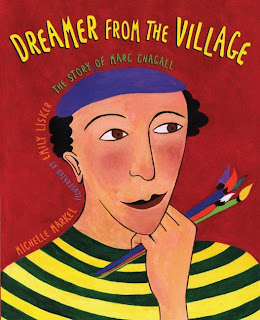
Shana Tova! Happy New Year! In honor of the Jewish New Year, I have been inspired to reach out to our wonderful community of writers and other supporters of Jewish literature for children. Since the publication of Like a Maccabee, I have had the opportunity to meet so many terrific folks, from librarians to writers and editors. I’m excited to share some of their insights and contributions.
I am pleased and proud to introduce my friend and SCBWI colleague, Michelle Markel. Michelle has written several picture books, both fiction and non-fiction. Her passion for art is evident in her newest book, a colorful biography about artist Marc Chagall.
Why were you drawn to write Dreamer From the Village: The Story of Marc Chagall?
Several reasons. I felt a connection to Chagall because of my Jewish roots, because my grandparents came from the Ukraine, as he did. I thought his art would appeal to children because it’s dreamlike, very emotional, full of vivid colors and flying magical beasts- what’s not to like? Thematically I was drawn to the story because it’s one of perseverance, of believing in oneself even when others don’t.
How did you to find the right publisher for the book?
I had a manuscript consultation at an SCBWI conference where an agent told me I’d need to find a Jewish editor for the book, which I ignored. A non-Jewish editor took interest in the story, and had me revise it a couple of times but ultimately passed on it. By total serendipity, the new improved version found its way to the desk of Marc Aronson at Henry Holt. Aronson was named after Marc Chagall- his father, a set designer, knew the artist in Russia and wrote about him before emigrating to the U.S. So the agent was right; the story was destined for a Jewish editor.
Who are some of your influences?
For biography, I was greatly inspired by Jonah Winter’s Diego. I picked up that book in the library when my girls were little. I thought it was as a magical little story about an artist, and it wasn’t until I came to the part where striking workers got shot that I realized it was a nonfiction book about Diego Rivera! It was a revelation to find a nonfiction book with spare, lyrical language.
What are the challenges of writing picture book biographies?
To distill the essence of your subject, you have to do nearly as much research as if you’re writing an adult biography. You have to decide on your themes, and then choose only the facts that support them. It’s hard to part with fun little details you’ve uncovered. It may be interesting that the young Chagall used to put rouge on his cheeks because he thought it made him more attractive. It’s amusing that early in his career he used to paint buck-naked. But when you’re writing a 1000 word picture book bio, you have to streamline the narrative.
Do you prefer writing fiction or non-fiction?
I like the total freedom of writing fiction, and watching my characters sculpt themselves out of thin air. I like the discovery process of non-fiction research, and that moment when I figure out the angle- how to make the subject enticing to kids. My book Dream Town has a little of both, so it’s what you’d call creative non-fiction.
Why did you start writing children's books?
I loved picture books as a child, especially Madeline. (I loved the spunky heroine and the jewel-tone colors of the illustrations, and found out only recently that Ludwig Bemelmans was influenced by the Fauves, as was Chagall!). After my daughters were born I discovered William Steig, Dayal Khalsa, Petra Mathers, Allen Say and other great writers. Since I’d worked as a freelance journalist, and already had writing experience, I had the nerve to think I could contribute something to the field.
What are you currently working on?
I’ve been researching certain Jewish women who fought for a better world. That’s all I can say for now.
What is the hardest part about being a writer?
For me, the challenge has been to find the right editor for my projects. I’ve written in several genres (fiction, non-fiction, creative non-fiction, biography) and have had to find the right person for each one of them.
What is the best thing about being a children's writer?
Since our audience is at an impressionable age, we’re in the position of making a big impact on our readers. And what a great audience they are! No one is more generous with praise than children. Call me a softie, but after a school visit I can never get enough of those crayon and construction paper cards that say "I Love You."
What are your hobbies? .
I go to art exhibits, concerts, hang around in bookstores, shop at Trader Joe’s.
What’s next?
My newest title is The Shark That Taught Me English, about an immigrant girl from Mexico (Lectura Books). It’s going to be a bilingual picture book, which I think is extremely cool.
Fun Facts about Michelle: She has worked as an au pair in France, and was translator for the 1984 Olymipcs!
Michelle, thanks for taking the time to book talk with me. It's been a pleasure!
Blog: OUPblog (Login to Add to MyJacketFlap)
JacketFlap tags: Economics, africa, Business, Politics, Current Events, oxford, A-Featured, A-Editor's Picks, economy, Paul, Finance, oil, Collier, bottom, billion, g8, aid, diamonds, labour intensive, manufacturers, sustained, growth, rebellions, coups, Add a tag
Rebecca OUP-US
Today we are thrilled to have an original piece from Paul Collier the author of The Bottom Billion: Why the Poorest Countries Are Failing and What Can Be Done About It. Below, Collier a Professor of Economics and Director of the Center for the Study of African Economies at Oxford University, argues that the G8 did not go far enough in its efforts to assist Africa.
Since the 1960s around a billion citizens of the world have been diverging from the rest of us at an accelerating rate, a trend which will generate unmanageable social pressures. Most of these countries are in Africa, and so it is appropriate that the region should again have been on the G8 agenda during the recent summit in Germany. (more…)



